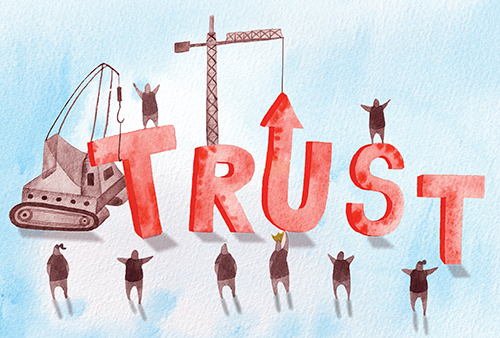Trust is critical for leaders. Without trust, leadership is impossible. The problem, however, is that trust always entails risk.
“Every stranger is a thief.” This old Japanese proverb presents a particularly pessimistic, risk averse approach to trusting people. It inspires no confidence at all in the trustworthiness of our fellow human beings; it’s as negative as you can get. At the same time, it avoids risks and it reflects what researchers call ‘a rational approach to trust development,’ i.e., don’t trust people at first and only after you have had a series of positive experiences with someone should your trust in them increase. Leaders who live by this model express it directly when they say to their team members, “You must earn my trust.”
Trust is critical for leaders. Without trust, leadership is impossible. The problem, however, is that trust always entails risk. It never feels good to trust someone and then be exploited. When someone violates your trust, the consequences can be sizable, both substantively and emotionally, and the negative impact tends to be much greater than the positive effects that result when people honor your trust. When things go well, it’s great, but when things go badly, it can be really, really bad.
In addition, a bad trusting experience can lead to disproportionate increases in our fears that it will happen again. Because fear is such a strong emotion, it makes negative trusting outcomes particularly memorable and this has a natural dampening impact on our future trusting choices. Think, for instance, of times when someone’s romance has gone bad. It often sours them on any romance for quite some time. This is why people have so much fear when they trust, and why they often choose not to trust when they actually might benefit by doing so.
[ms-protect-content id=”9932″]In fact, the research on this is very clear; bad outcomes tend to seriously outweigh comparable good outcomes in our minds because they are vivid, available events. Our memories are not egalitarian; we remember events that stand out, and negatives stand out much more than positives do. This is particularly true for people who have trusted and been burned; trust violations are vivid, emotionally charged events. As a result, they affect us emotionally and they influence our subsequent decision making much more than positive outcomes do.
The counterpoint is that leaders may suffer from distrust less than they expect. Why? Primarily because most leaders deal with people who are professionals, i.e., people who care about their jobs. Professionals work in all sorts of jobs, from low-level managerial positions to handling shipments at the company’s loading dock. In the simplest and most important sense, professionals are people who want to do their jobs well. Leaders can encourage people to be more professional (more on this later), but the basic notion of being a professional has all sorts of positive consequences. In particular, it suggests that professionals are people who want to retain their jobs. They are also smart enough to know that it pays to be trustworthy.
How then should leaders deal with the vexing dilemma of trust? Trust the wrong people too many times and your career can be over and your organization can fail. Trust too little, however, and you can never get very much accomplished. How can leaders know how to strike the right balance so that they can obtain all of the mutual benefits that trust can supply while avoiding the downsides that come with their trust being violated?
First, it pays to do at least a little if not a lot of homework. Untrustworthy people clearly do exist, and making a mistake and trusting them can be incredibly costly. The best way to avoid these costs is to know as much as you can about the people you are dealing with and, when you trust someone, realize that there is always a chance that your trust will be violated.
Achieving an optimal balance of trust and risk is clearly a critical leadership issue. Getting this right can make a huge difference in a leader’s life and career. Fortunately, a recent burst of research evidence can help leaders answer this question effectively. At the same time, it’s important to note: if you trust many people, sooner or later you are going to get burned. Likewise, if you trust only a few, you will miss out on a host of opportunities. To explore the various approaches to trust, let’s consider an example to see what can happen to a newly promoted leader.
Your Dream Come True
Imagine that you have been working for a large company for some time. Your supervisor comes to your office and says, “Congratulations. It’s time for your next promotion, a big one!”
Needless to say, this is good news. In fact it turns out to be more than good news, as you have coveted this position for some time. You will now be leading a successful group in a challenging, growing area of the firm. It’s a dream come true.
You have heard great things about the team. They are all professionals and each of them has been working for the firm for a year or more. Thus, it is clear that they are competent, and the scuttlebutt in the company is that they perform well as a team. At the same time, you are confident about bringing some new ideas and some new energy so that the team can achieve even more.
There is a bit of time before you take over. Although this is a dream-come-true job, one that you have always wanted, you naturally have some questions. Most of all, you want to learn as much as you can about your new team members. Although you have a whole host of questions, your three most important questions are:
1. How competent are they?
2. How trustworthy are they?
3. Do they have any personality conflicts that interfere with their performance?
You would like to get answers to these three questions soon, before you take over the team. You’d also like to get this information without stepping on any toes. Thus, you seek out the team’s current, soon-to-be leaving leader. You ask about each of the team members, about what they can do and what they can’t do, about their initiative and timeliness, about their limitations and their aggravating habits, etc. Their soon-to-leave boss is amazingly open and helpful and tells you everything that she possibly can.
Your second step is to look at your new team members’ personnel files. Not surprisingly, the files are only mildly informative: they reveal when each person was hired, their initial and current positions, their latest evaluations (this seems to be the most helpful information in the file), a good description of their current job responsibilities, and a few pieces of demographic data. Although this is helpful, it’s not the specific, micro-information that you are really looking for.
You realize that both of these sources of information have been helpful but they are both limited. In particular, as helpful as their current leader has been, she can only tell you about the team members’ previous interactions with her – she can’t say how they will interact with you. You have also talked with other people who have worked with the team, but they also have their own idiosyncratic perspectives. Thus, you are beginning to form a picture of each of the new team members, but they are not great pictures: your information is obviously far from complete. At the same time, you continue to be really excited about this great, new opportunity.
If you are seriously concerned about not making a misstep as the team’s new leader, you might take a very rational, incremental approach and do what many new leaders do: give each team member a small task.1 In your mind, these are actually tests, but you don’t reveal this to the team members. Instead, you simply present them with these small tasks and then track how they perform. You are hoping that their performance will reveal their competence and the range of their skills and, by giving them a small task, you are not risking too much.
Unfortunately, all of your new team members come back with either poor or thoroughly mediocre performance. They have not done well at all. Now what?
Many new leaders conclude that this new job is not what they thought it would be, that this team is not so great, and that their work is really cut out for them.
In fact, they have learned absolutely nothing.
Why? First, all of the new team members are professionals and they have been with the company for over a year. In other words, they know what they are doing and what they are capable of.
In addition, their antennae are out; they are getting a new leader and they are understandably curious about what you will be like and, most importantly, how you will treat them.
Finally, they have been working together as a team for some time. They probably talk with each other, and a particularly important topic for them is their new leader and the first job that you have given them. Thus, they haven’t gone off, in isolation, to each do their own job independently. Instead, they have talked to each other and have realized that all of them got jobs that were beneath them, possibly even insulting. They quickly realize that you are testing them. (This doesn’t take great skills at detection.) As professionals, they can’t help but be offended at being assigned such menial tasks. In addition, it gives them their very first signal of how much you trust them, i.e., not much. For people who are proud of what they can do – and this is as good a definition of being a professional as any – this is not a good start to your tenure as their leader.
Thus, even though you were trying to be careful, even though you didn’t want to take a big risk, even though you thought that you were being completely rational, your first leadership act in the job that you have always dreamed about has backfired. None of this is good, for you, the team, or your organization.
Some Intuition
Let’s shift gears away from this sad story and consider your own career. Have you ever seen a supervisor, a boss, or an authority figure trust someone more than they anticipated? This can happen in a team meeting or a one-on-one interaction when a boss gives someone a more challenging job, with more discretion and authority than they ever expected.
For the last seven years, I have asked the executives in my classes if they have ever had this experience; about half of them raise their hands. When I ask them how they have responded to this experience, they all have exactly the same answer: they say that, when they were trusted more than they expected, they stepped up and exerted extra effort to show the person who had trusted them that they were worthy of their trust. Every single one.
Their responses are a very clear message. If you want to be a more effective leader, if you want to get the same response that all of my executives’ bosses got, do what they did: trust more.
If we go back and apply this insight to our story of your dream promotion, your team members’ personnel files will provide you with the information you need to determine just how much to trust everyone, because they will indicate what your team members have been working on lately. Thus, all you need to do to activate their desire to live up to your trust is to give them a job that’s a bit more challenging than what they have been working on. Not a lot more – you don’t want them to fail – and not something that they don’t have the skills for either. Just a bit more challenging than what they are now working on. If they are anything like all of the professionals I’ve talked to, they will step up, too, to show you that they are worthy of your trust.
Trust, Risk, and Fear
Why don’t we do this? Why don’t we trust people more? In a word, fear: people are afraid that if they trust someone too much, their trust will boomerang on them, and they will be hurt more than if they hadn’t trusted at all. Thus, people are naturally cautious: it takes them awhile to be comfortable enough to trust people more.
Clearly, trusting always entails risk. Who to trust, when, and how much should depend on what you know about the person and the situation. You must do your homework. You should never trust blindly. New employees should always have probationary periods to prove themselves and no boss should ever hire a convicted felon to handle a cash business.
Research tells us that other factors are also involved in this process. People around the world, in every culture, have a universal, natural reaction to reciprocate. Doing a favor for someone or giving them a gift typically leads people to respond in kind: you scratch my back, I’ll scratch yours. In ancient times and in ancient cultures, the negative side of reciprocity may be best exemplified by “an eye for and eye and a tooth for a tooth.” Reciprocity’s turn-taking is normal and natural. It is another reason why professionals consistently step up when they’ve been trusted more than they expect: they reciprocate their leaders’ trust in them.
By trusting more, leaders can start a positive chain of reciprocity. Taking a risk with a professional has a very high probability of resulting in the person stepping up and doing their best. This should encourage leaders to trust them more, creating a continuing positive cycle. In contrast, when leaders don’t trust much, they and their team members not only miss a golden opportunity to create the mutual benefits that come from trusting, but they may also be starting a negative chain of reciprocity. In the absence of trust, people tend to be suspicious, and when leaders don’t take trusting opportunities, suspiciousness and all of the negatives that accompany it can grow. Thus, the fulcrum between trusting and not trusting can be critical, and can lead to great positives or serious negatives.
In essence, leaders have two basic choices: they can trust their people, or they can be seen as micro-managers. It’s simple, and potent: don’t trust people and they will wonder why; trust them and, if they are professionals about their jobs, they will reciprocate and reward your trust in them. Not all the time, of course. Obviously, people make mistakes. But you will do far better by trusting more than by trusting less.
This also suggests that leaders trust too little far too often. Most would benefit by trusting more.
There’s another common impetus to trusting more. Most leaders interact with the same groups of people over and over again: they tend to work with the same team members; their best customers are often people who come back repeatedly; and stable relationships with suppliers are so mutually beneficial that both buyers and sellers can reap great benefit from long-term, mutually-reinforcing interactions. In short, many of our interactions are with people we know, whom we will see again, repeatedly. These kinds of relationships drastically reduce the likelihood that people will violate our trust. The conclusion is clear: leaders should Trust People More. They will benefit and their team members will benefit by building positively reciprocal relationships. It doesn’t have to be hard. In addition, by trusting competent professionals more than they anticipated, you don’t have to wait for them to “earn your trust”; they get it right away.
Will it work for everyone? Obviously not. Some people don’t want new challenges and some people don’t want more responsibility.
But overall performance will be better; most team members will be happier and feel more responsible; and, if you are a new leader, trusting your team members more can be a tremendously positive first step on your first day on the job. To be maximally effective, new leaders must send strong signals that create strong, positive impressions with their very first acts as a team’s new leader. It is far too easy to start with a strong, negative impression. By taking a less-than-natural risk, i.e., trusting people more than they expect, new leaders can build a tremendous foundation for their future efforts.
This article is adapted from a chapter from “Do Nothing! How to Stop Overmanaging and Become a Great Leader“, by J. Keith Murnighan(Portfolio/Penguin, 2012).
About the Author
J. Keith Murnighan is the Harold H. Hines Jr. Distinguished Professor of Risk Management at the Kellogg School of Management, Northwestern University. He has taught, consulted, and trained people around the world. His most recent book is Do Nothing! How to Stop OverManaging and Become a Great Leader. It will be published by Portfolio/Penguin. His previous books include Bargaining Games: A New Approach to Strategic Thinking in Negotiations (William Morrow, 1992) and The Art of High-Stakes Decision-Making: Tough Calls in a Speed-Driven World (with John Mowen; John Wiley & Sons, 2002).
Homepage: keithmurnighan.wordpress.com
Email: keithm@kellogg.northwestern.edu
[/ms-protect-content]




































